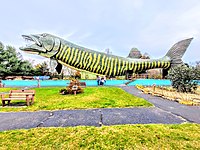
Photo from wikipedia
In this study, we assessed the potential of aqueous extract (CSEaq) of Cuminum cyminum L. (cumin) seeds in protecting WRL-68 cells from hexavalent chromium [Cr(VI)]-induced oxidative injury. Cells exposed to… Click to show full abstract
In this study, we assessed the potential of aqueous extract (CSEaq) of Cuminum cyminum L. (cumin) seeds in protecting WRL-68 cells from hexavalent chromium [Cr(VI)]-induced oxidative injury. Cells exposed to Cr(VI) (10 μM CrO3) for 24 h demonstrated a twofold increase in ROS, which, in turn, led to extensive oxidative stress, consequently causing colossal decline in cell viability (by 58.82 ± 9.79%) and proliferation (as was evident from a reduced expression of Ki-67, a proliferation marker). Immunofluorescence studies showed that Cr(VI) diminished the expressions of mTOR and survivin in WRL-68 cells. It also led to a substantial elevation of BECN1 expression, which suggested autophagy. Overall, our results indicated that 24 h exposure of WRL-68 cells to Cr(VI) caused oxidative stress-induced autophagic cell death. CSEaq was found to protect WRL-68 cells from the same fate by refurbishing their viability and proliferation in a dose-dependent manner. The extract reduced ROS in these cells, which consequently decreased the degree of autophagic cell death by restoring expressions of mTOR, survivin and BECN1 to their respective normal levels. Biochemical assays revealed that CSEaq is rich in phenolic constituents. Total phenolic content of CSEaq demonstrated positive correlations with (i) its antioxidant potential, (ii) its alleviation of cellular oxidative stress and (iii) its cytoprotective efficacy in Cr(VI)-treated WRL-68 cells. We also identified the major phenolic constituents of CSEaq. Our study suggested that polyphenols in CSEaq might be responsible for protecting WRL-68 cells from Cr(VI)-governed oxidative assault that would have otherwise led to survivin/mTOR-mediated autophagic death.
Journal Title: 3 Biotech
Year Published: 2020
Link to full text (if available)
Share on Social Media: Sign Up to like & get
recommendations!